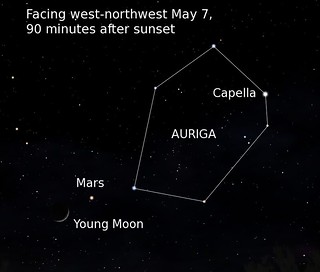Northern Sky: April 27 - May 10, 2019
NORTHERN SKY by Deane Morrison
April 27-May 10 2019
Here we are again, moving from April into May, and the winter stars are disappearing in the west. But they’re not all gone yet. Case in point, a little while ago, a friend asked me about a couple of bright stars he had seen in the west around nine thirty the night before. Both were about the same distance above the horizon. So I took a good guess, and went out that night, and sure enough, what had caught his eye was the winter stars Procyon, in Canis Minor, the little dog, and Capella, in Auriga, the charioteer. Right now these two stars are getting ready to set for the season. If you haven’t seen them but you’d like to, go outside as soon as the sky gets dark, and you should see two bright stars not far above the western horizon. Procyon is on the left, Capella on the right. Above and between them are the Gemini twins, Pollux, that’s the brighter twin, and Castor.
This winter I’ve talked about all these stars except Capella. It’s a beautiful star, and when it’s low in the sky, Earth’s atmosphere often acts like a prism and makes it twinkle red and green. From the latitude of Grand Marais, it’s a circumpolar star. That is, it travels in a circle around the Pole Star, Polaris, and never sets, although in summer it gets a little too low to see very well. The stars of the Big and Little Dippers are also circumpolar. If you could follow a circumpolar star all day long, you’d see it complete one circle around Polaris every day. And if you noted its position at the same time every night for a year, you’d see it circle Polaris then, too.
Capella is also a multistar system. It has a close pair of big yellow stars, both a lot brighter than the sun and with about 2.5 times its mass. It also has a pair of little red dwarf stars orbiting the big yellow stars at a distance of about 10,000 times the distance of Earth to the sun.
The name Capella refers to the “little female goat” that the charioteer is carrying. Below Capella you may be able to make out three fainter stars that form a narrow triangle. These are called the Kids.
On May 7, Capella will be part of a string of objects lined up diagonally from lower left to upper right at nightfall, but not much longer afterward. Starting at the lower left end, we have Betelgeuse, in Orion; then a young crescent moon; then Mars, and finally Capella. On the evening of May 9, a heftier crescent moon will be between Procyon and Pollux.
And speaking of evenings, sundown on April 30 marks the beginning of the astronomically based Celtic holiday called Beltane. It was one of four cross-quarter days falling midway between an equinox and a solstice. Beltane marked the end of the dark half of the old Celtic year. The dark half began at Halloween, when all the evil spirits were set loose upon the world to vex humankind for the next six months. And that made sense; winter is the time when hunger, cold and diseases like flu run rampant. But when the end of April rolled around, things changed. At sundown on April 30, the nasty spirits came out for a last fling. Then, at sunrise on May 1, the party was over, and the spirits were again banished until sundown on October 31. The night of April 30 is also called Walpurgis night, but only because May 1 is associated with St. Walpurga, who had nothing whatsoever to do with any of this.
Tweet




